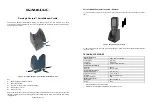
WMS831
WIRELESS DATA LOGGING WEATHER STATION
USER’S MANUAL
INTRODUCTION
Thank you for purchasing Omega’s Weather Station with
remote control. This compact and easy-to-use product
features a wide variety of time and weather data, such as
precise atomic time, perpetual calendar, air temperature,
relative humidity, barometric pressure, wind speed and
direction, rainfall, and etc.
PACKAGE CONTENTS
In this package you will find:
•
One Main Unit (receiver)
•
One Rain Gauge (remote rain sensor/transmitter)
•
One Anemometer (remote wind sensor/transmitter)
•
One Three-Channel Temperature & Humidity Sensor (transmitter)
•
One 7.5V AC/DC Adapter
•
Mounting Hardware with wrench tool
•
One User’s Manual
Components:
•
Main Unit
•
AC/DC 7.5V power adaptor
•
Thermo Hygrometer Sensor
•
Rain Gauge
Consists of:
Funnel shaped top with battery compartment
Rain Gauge bucket
Bucket see-saw mechanism
Protective screen
`
•
Anemometer
Consists of:
Wind Cups
Wind Vane
Anemometer arm
Anemometer base
•
Mounting hardware:
4 screws for securing rain gauge to the flat surface;
4 screws for securing anemometer to vertical surface
INSTALLATION
Our Omega’s Full Weather Station #WS821 operates at 433MHz radio frequency, so no wire installation
is required between the main unit (receiver) and the remote weather sensors (transmitters). The remote
weather sensors include a thermo-hygrometer (temperature and humidity) sensor, anemometer (wind
sensor) and a rain gauge (rain sensor). All data measured by these remote sensors is transmitted to the
main unit wirelessly, with the operating range up to 328 feet (100 meters) in the open area. The
Anemometer and a rain gauge must be placed outdoors to measure weather elements. Remote thermo-
hygrometers can be placed indoors or outdoors, depending on the location where the temperature and
humidity are to be measured. If you intend measuring outdoor temperature and humidity, place the
remote sensor outdoors, preferably not in the direct sunlight.
NOTE:
It is critical to assemble and power up all of the remote weather sensors BEFORE setting up the
main unit.
NOTE:
It is critical to power up and test communication between all of the weather sensors and the
main unit BEFORE permanently mounting them outside.
BEFORE YOU BEGIN
•
We recommend using alkaline batteries for the remote weather sensors and the main unit when
temperatures are above 32°F (0°C). We recommend using lithium batteries for the remote weather
sensors when temperatures are below 32°F (0°C).
•
Avoid using rechargeable batteries. (Rechargeable batteries cannot maintain correct power
requirements).
•
ALWAYS install batteries in the remote weather sensors before the main unit.
•
Insert batteries before first use, matching the polarity in the battery compartment
•
Remove protective plastic screen from LCD display (if any).
•
During an initial setup, place the main unit close to the remote weather sensors.
•
After reception is established (all of the remote readings will appear on the main unit’s display),
position the remote sensors and the main unit within the effective transmission range of up to 328
feet (100 meters). Ideally they should be placed within the line of sight of the main unit. See
placement tips in the user manual for each remote weather sensor separately.
•
Transmission range may be affected by trees, metal structures and electronic appliances.
•
The main unit must be placed indoors.
•
The effective operating range may be influenced by the surrounding building materials and how the
receiver (main unit) and transmitters (weather sensors) are positioned.
•
Place the remote weather sensors so that they face the main unit (receiver), minimizing obstructions
such as doors, walls, and furniture.
NOTE:
When the temperature falls below freezing, the batteries in the outdoor remote weather sensors
may have reduced voltage supply and a shorter effective range. We recommend using lithium
batteries at temperatures of 32°F (0°C) and below.
IMPORTANT:
Make sure that the remote weather sensors are easily accessible for cleaning and
maintenance.We recommend cleaning the remote weather sensors periodically, as the dirt
and debris may affect sensors accuracy.
THERMO-HYGROMETER SENSOR
FEATURES
•
Remote data transmission to the main unit via 433 MHz signal
•
328 feet (100 meters) transmission range without interference
•
LCD display of measured temperature and humidity
•
Three (3) transmission channels selection
•
Case can be wall mounted using built-in hanger
•
Up to three T-H sensors per station are permitted
1






























